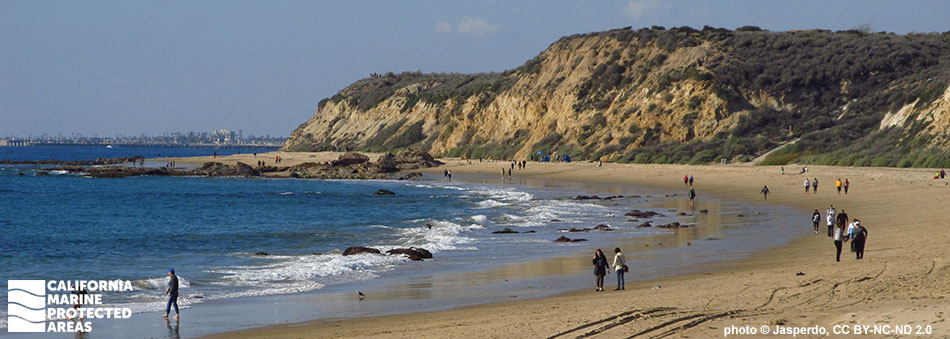
Overview
Crystal Cove State Marine Conservation Area (SMCA) is located 10 miles south of the city of Huntington Beach along Highway 1 and sits adjacent to Crystal Cove State Park onshore. This SMCA, which covers more than three square miles of marine habitat from shore to depths of nearly 250 feet, is popular with beachgoers, whale watchers, anglers, and scuba and free divers.
Stretching more than four miles along the coast, the coves, sandy beaches, rocky reefs, and kelp forests within this marine protected area (MPA) support a large variety of fishes, invertebrates, marine mammals, and rich tidepool communities. Dolphins and sea lions are commonly seen from shore, and snorkelers and divers who venture beyond the waves can explore the giant kelp forests and swim amongst garibaldi, señorita, opaleye, and a variety of perch species. Onshore, tidepools exposed by a low tide provide curious observers the chance to see marine life like anemones, crabs, and sea stars up close.
Regulations
It is unlawful to injure, damage, take, or possess any living, geological, or cultural marine resource, EXCEPT:
Recreational take of finfish by hook-and-line or spearfishing and take of spiny lobster and sea urchin is allowed. Commercial take of sea urchin; spiny lobster by trap, and coastal pelagic species (northern anchovy, Pacific sardine, Pacific mackerel, jack mackerel, and market squid) by round-haul net, brail gear, and light boat is allowed. Not more than five percent by weight of any commercial coastal pelagic species catch landed or possessed shall be other incidentally taken species. Take of living marine resources from tidepools is prohibited.
California Code of Regulations Title 14, Section 632(b)(133)(opens in new tab)
Quick Facts
MPA size: 3.53 square miles
Shoreline span: 4.3 miles
Depth range: 0 to 245 feet
Habitat composition*:
- Rock: 1.19 square miles
- Sand/mud: 2.99 square miles
*Habitat calculations are based on three-dimensional area and may exceed the total MPA area listed above.